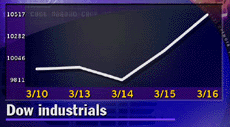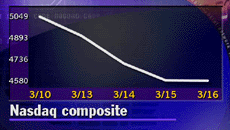|
Dow vs. Nasdaq, what now?
|
 |
March 16, 2000: 2:20 p.m. ET
How investors should react to the index switch during the past two days
By Staff Writer Alex Frew McMillan
|
NEW YORK (CNNfn) - Like Laurel and Hardy trading slaps, the Dow and Nasdaq keep jostling, a pair of opposites - "old economy" versus "new economy" -- consumer goods versus tech.
Given the market's split personality, investors - no matter what investment advice they followed -- are left chanting one refrain -- this is another fine mess you've gotten me into.
With Nasdaq near correction levels after the last couple of days, you might be asking what happened to all that hype about the second Industrial Revolution. The Dow roars back. And, well, what are investors supposed to think now, exactly?
"I know people think three days is long term in the market these days," said Scott Kahan, a certified financial planner and president of Financial Asset Management in New York. "But if you're a long-term investor, 2, 3, 4 percent swings, which are big moves in a day, are meaningless when you look back."
The idea of a real-life remake of the movie "Trading Places" may make a gripping story, but before you ditch all your tech holdings and buy back that Procter & Gamble (PG: Research, Estimates) stock you dumped last week, remember that people thought a similar rotation shift was going on around this time last year.
There was a lot of talk about the resurgence of cyclical stocks, for, oh, approximately three weeks, Kahan points out. And at the end of the year, Nasdaq was up 85.6 percent, with the Dow up 25.2 percent.
 "Is two or three days really a time frame to look at a rotation shift that's significant?" Kahan asked. So people have made back some of their losses in Dow stocks in the last two days. Big deal. "Let's look at it in two months or three months and see what's happened." "Is two or three days really a time frame to look at a rotation shift that's significant?" Kahan asked. So people have made back some of their losses in Dow stocks in the last two days. Big deal. "Let's look at it in two months or three months and see what's happened."
The positive sign for the overall market is that investors aren't taking money out of the market, they're just shuffling it around. And there are a lot of cheap "old order" companies out there after a shoddy 2000 so far. Market watchers say Nasdaq couldn't keep striking new highs while the Fed's strong stance hurt the Dow and anything non-tech.
"I think there were just overbought conditions in Nasdaq and oversold conditions in older-company stocks," said Tom Galvin, chief investment officer for Donaldson Lufkin & Jenrette. "The rubber band had gotten too extreme, and now is being snapped back to some level of convergence."
The broad discrepancy in the year-to-date performances of the Dow and Nasdaq has corrected a little. The million-dollar question naturally is, how long can this keep going?
Galvin gives it a few days, weeks at the outside. "Nasdaq will continue to move toward new highs as we move toward earnings reports in April," he said. The Dow-Nasdaq switch is a short-term trend rather a major shift, he said.
"At the end of the day, this is still a growth market, and the best growth remains in technology," Galvin said.
Individual investors are notorious for following trends and chasing returns. "Historically it's been 'Buy high and sell low,'" Kahan said. Wait a day or two and it may be too late to jump on the Dow bandwagon. It may already be too late.
Financial planners say individual investors shouldn't be playing the market timing game like that in the first place. Only day traders need to heed every move in the market, they say.
"If you watch it too closely you'll just go crazy," said Nick D'Ambrosio, a certified financial planner with Horizon Planning in New York.
 But contrarians are likely to ask - "does an almost 10 percent correction in Nasdaq make for a buying opportunity in tech and Nasdaq stocks?" But contrarians are likely to ask - "does an almost 10 percent correction in Nasdaq make for a buying opportunity in tech and Nasdaq stocks?"
Bernie Schaeffer, president of Schaeffer's Investment Research, pointed out that the Nasdaq 100 (QQQ: Research, Estimates) is reaching bottom on its 10-week moving average, at around 200.
That has proven "very supportive," he said. Schaeffer also measures the options traffic of puts and calls to get a read on where options traders see stocks moving. Sentiment still seems strong.
"Given that we've got some potential technical support coming up and sentiment is good, right around here might be as far as the pullback is going to go," he said.
If you're uncomfortable about investing in "new economy" stocks - technology stocks -- he suggested buying companies with feet in both camps, such as Charles Schwab (SCH: Research, Estimates) or Merrill Lynch (MER: Research, Estimates), old-order financials that stand to gain from growth in online trading.
Financial planners recommend a cautious approach. Kahan said he would buy Nasdaq stocks and technology stocks on pullbacks. But if, say, an investor had $20,000 they were looking to put in tech, he'd advise them to invest half on the pullback now and keep the rest out of the market until another pullback.
D'Ambrosio is looking for further correction before he's comfortable. "If it [Nasdaq] goes down another 10 percent or so, I'd definitely be a buyer," he said.
But he's cautious now because the outlook for the rest of the year is not that encouraging for all stocks, he thinks, with Alan Greenspan and the Fed still trying to cool the economy and the market.
"If he keeps putting pressure on, eventually it's going to work," D'Ambrosio said. "He's got the magic wand if he wants to use it." If Greenspan really wants to take to tech stocks, which he has often cited as overvalued, he could even raise margin rates, D'Ambrosio pointed out. That could have a drastic effect because many investors who are heavy in tech stocks have been buying on margin.
However, you don't want to fight the Fed in the first place -- market watchers joke that the market might win a few battles, but the Fed always wins the war.
"The people running tech stocks up think they're immune [to interest rates]. I'm a conservative guy. I don't think they're immune," D'Ambrosio said.
In the long term, you're highly unlikely to lose if you believe the tech story and invest in it, he said. But the path isn't a straight line. Trying to time the market leaves you open to timing it wrong on either Dow stocks or tech stocks.
Given the choppy character of the markets lately, he is 60 percent in stocks and tempted to keep cash on the sidelines. "It's a dangerous time," he said. "I'd certainly like to see Nasdaq correcting another 10 percent, and I'd like to see a little bit more of Greenspan not waving his sword." 
|
|
|
Track your stocks
|
Note: Pages will open in a new browser window
External sites are not endorsed by CNNmoney
|
|
|
|
 |

|

